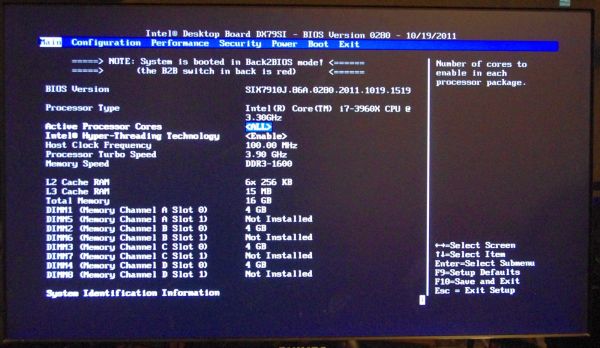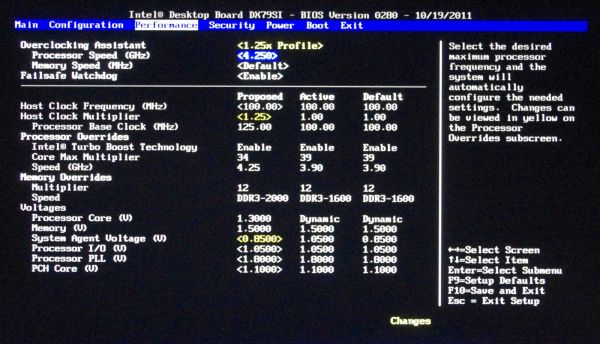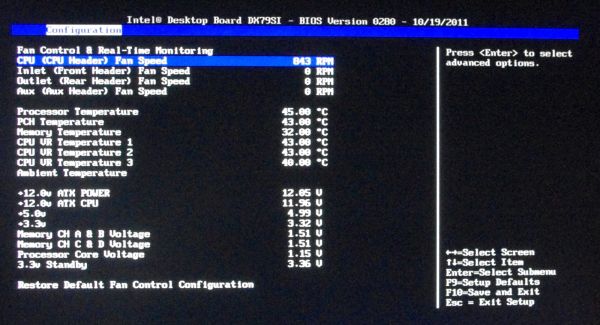Intel DX79SI Review: The Default X79?
by Ian Cutress on November 18, 2011 1:10 AM EST- Posted in
- Motherboards
- Intel
- X79
BIOS
Having not personally delved into an Intel motherboard BIOS for quite a while, it was going to be interesting to see their take on the grand cityscape of graphical BIOS opportunities. As I postulated earlier, it is hard to gauge just how much time, effort and people Intel put in this department, given they are more in the market for selling processors and chipsets. The answer to this could be considered straightforward after booting into their BIOS.
Do not expect much in the way of graphics, unless you have a penchant for ASCII art. However the first screen does contain a lot of info that other motherboard manufacturers do not bother to show right off the bat – BIOS version, processor, speed, frequency, memory and memory speed. In the best graphical implementations on other products we also get fan speeds and voltage quick reference values, so there is definitely room for improvement here.
The primary screen of interest however is the performance section for overclocking. Right at the top is the Overclocking Assistant, where the user can select either a 1.00x or 1.25x gear ratio (I’ve heard that only 1% of CPUs can do a 1.66x ratio, so there’s method in limiting it to 1.25x here), which creates a processor speed menu underneath for selecting an optimum CPU speed. These are sets of predefined CPU values pre-programmed into the BIOS, so your mileage may vary – make sure there is sufficient cooling at hand. I will go through these options later in the overclocking section.
What’s odd about this menu is that the ‘Processor Overrides’ and ‘Memory Overrides’ sections are actually expandable into new screens of options – this isn’t immediately obvious when you first look at it. The processor related screen deals with voltage, V-Droop, Turbo Boosts technology and power limits, whereas the memory configuration is where we deal with XMP and sub-timings. If you have manually overclocked before, there is not anything here that should be confusing.
Of importance to a lot of people are the fan control options. As the OS controls are non-existent, we are left to navigate the BIOS to optimize the four fan headers on board. The Real-Time Monitoring screen shows information relating to current fan speeds, temperatures and voltages. In a similar fashion to the performance screen, it is not painfully obvious that the fan speed values actually delve into sub menus where more specific fan controls can be adjusted. In this respect, Intel should probably consider a little notification or color change to an option which is a sub menu.
One main criticism levied at a lot of motherboard manufacturers is the limited amount of ways a user can enter a value in a BIOS. Take something as simple as a voltage setting – some users like to use a the plus/minus keys, some like to choose an offset, some may perhaps even enjoy a menu to select values, while others like myself prefer a direct entry method. Unfortunately, Intel is let down here in terms of direct entry. The menu system is also questionable, with the ‘default’ setting near the 1.0000 V option, requiring the user to scroll all the way to 1.3 V or above for a specific setting.
Overclocking
As I noted back in my review of the ASUS P9X79 Pro, overclocking on the X79 is slightly more involved than P67/Z68, but not as complex as other Intel platforms. We have a ‘gear ratio’ to select (usually 1.00x or 1.25x) which gives a default frequency of either 100 MHz or 125 MHz, then we can adjust +/- a few MHz as with Sandy Bridge.
Intel thankfully provides a series of Auto-OC options in the BIOS, either on the 1.00x or 1.25x ratios as required. To start, I tested the first ratio, which offers 4.0-4.6 GHz on the multipliers. The voltage settings would automatically be adjusted depending on the speed chosen – 4.6 GHz being run at 1.42 V. The board would eventually boot at 4.6 GHz (for some reason it had two failed attempts), but while in the OS it was rock stable, passing a Blender stability test. I did notice however, that if the board was booted at this speed, and then the Auto-OC options were ‘disabled’, as the board still had that 46x option in memory, it would still boot at that level, which is contrary to what the user is selecting.
At the 1.25x gear ratio however, things were not as peachy. While it still offers a good range of CPU speeds to chose from (~4.0-4.625 GHz), the board would simply not apply the gear. Even if this was set manually, the gear would not engage, leaving the CPU at 1.00x on the gear and 35x on the multiplier. There is something not latching in the BIOS to apply this setting – hopefully this will be remedied in an update.
In turn, I tried adjusting the settings manually. As with the ASUS X79 review (and future reviews), I limited the CPU to 1.4 V and adjusted the multiplier. The highest setting that was truly stable was 47x; 48x would usually boot (if the power limits were increased), but would at some point fail a stress test.
For memory, there are several options a user can pick. There are Auto-OC options, which are from 1600 MHz to 2133 MHz, in the subtiming menus a user can select XMP, or manually adjust the DRAM strap. The Auto OC options were an odd sort – at 1600 MHz, the memory would be set to 8-8-8, at 1867 MHz we would get 8-10-8, then at 2133 MHz it would default to 9-9-9. This last setting would not boot on my 2133 9-11-9 kit; I am under the impression that the automatic sub-timings were not optimized for this memory kit. In terms of manual adjustment of timings, it’s actually quite rough – none of the options are able to be set on ‘auto’, so you have to know all the exact sub-timings for your kit.
XMP settings worked well, though it selected DDR3-2000 8-10-8, rather than DDR3-2133 9-11-9 to which my kit should be set to. After speaking with G.Skill, I have been told that for some reason there are XMP issues for those boards which are not XMP 1.3 rated. Nowhere in the Intel specifications can I find that the DX79SI is XMP 1.3, though it would be quite odd if it was not.
As a combined overclock, there are more issues to contend with. If an Auto-OC option is selected for CPU, you cannot select XMP on the memory, you have to use an Auto-OC DRAM option, which as said previously, is not exactly pushing your DRAM to the limit. Nevertheless, taking into account temperatures and options, the 4.4 GHz Auto-OC option at the DDR3-1867 works well.



















60 Comments
View All Comments
Blaze-Senpai - Friday, November 18, 2011 - link
I always thought Intel made their boards as a "reference" like Nvidia makes "Reference" cards; great if you want a basic but reliable board that doesn't have 9001 features you can mess with and set something on fire with at least.As for All Intel Branding... if only Intel made RAM...
Bristecom - Saturday, November 19, 2011 - link
Wow, the price of motherboards has really gone up. My top of the line Intel mobo from 2004 (D875PBZ) and my brother's top of the line Intel mobo from 2008 (DX48BT2) were only about $150; now they're double!BTW, I'm kind of surprised you didn't mention the audio here. But I guess nobody cares about onboard audio anymore since they're all basically the same Realtek codec?
Anyway, thanks for the review AnandTech, you always have the best reviews on the net!
Bristecom - Saturday, November 19, 2011 - link
Guys, I just had a look at Intel's Product Brief on this motherboard here: http://www.intel.com/content/dam/doc/product-brief...It says UV Reactive SATA Cables ARE included! Also, strangely, it lists under "Hardware Management Features" that it has "Processor Fan Speed Control" and "System Chassis Fan Speed Control!" AND it lists PCI Express 3.0 for all three ports! So if these specs are indeed correct, this review needs to be updated. Perhaps the reviewer got a crappy pre-release model/prototype?
rallyhard - Saturday, November 19, 2011 - link
Don't mean to be rude, but I expect a little more out of AT than:"However, to an enthusiast, it is strange to say that they sell well "
"While ASUS, Gigabyte, MSI and the test have teams of designers for graphical interfaces"
"I can much use for this in case errors arrive"
"A lot of motherboard manufacturers in X79 should be placing the first and second PCIe slots at least an extra PCIe width apart"
"There is a big gap in the I/O"
...and that was only on the first page.
Are other commenters just holding their tongues to be nice, or...?
marraco - Sunday, November 20, 2011 - link
-I love how small those chips are getting. Each year they appear more and more like if they were printed on the PCB.-They should put the first PCI slot nearest to the processor, because is the only one place which can be used to plug video cards without being blocked.
That would need extra space on the case for the last video card, if it takes 2 slots, but most cases have that extra space, so I think that blocking a potential PCI slot is worse that blocking a potential third card.
You do not want to put a triple video card system on a small case, because of airflow and cooling constrains. But if you spend all that money, is more probably that you also will invest on other cards, like decent sound.
-As ever, Intel motherboards are crappy and expensive.
Questor - Sunday, November 20, 2011 - link
While I agree, dual LAN without teaming seems a bit silly at this point in history and missing other bells and whistles (new BIOS type) at it's price point is a bit disappointing. However, unless I read this review cross-eyed (trust me, I have sleep problems, it's possible), this Intel board performs better than most of the 3rd party manufacturers who have much bigger groups working on developing their bread and butter products. Slot placement has seemingly always been a gripe by consumers from every board maker at various releases and certainly not an exclusive to an Intel board. I am not defending it, I am just saying, I have seen (maybe not here) board become recommended even though slot placement was a con many times.Maybe I am missing something here, but when a board is rock solid reliable, overclocks decently (if that is a feature a customer wants), and out-performs and/or is on par with 3rd party board performance at or near the same price point, isn't that a win?
I have never owned an Intel board in my life. If I read around the 'Net and see similiar performance comparisons, this could be my first.
soltys - Monday, November 21, 2011 - link
While I agree with some points, 2 things i'd like to point out:- looking at the /relatively/ slim and non-bloated software controls - they are already a reason for some award ('common sense' one perhaps ?). Relatively to the bloat other companies can stuff ... one often avoids using them because they are essentially a few checkboxs / sliders weighting heavy tens or hundreds (CCC, *cough*) megabytes; leaving aside well guessed reasons
- subjectively, I've always considered a front panel with knobs as a proper method to control fans, not a software
ReySys - Tuesday, November 22, 2011 - link
I always use this motherboards. In last times I was hoping to try a Asus. But Intel MB are very stable. The warranties are excellent. Fail is a rarity in this motherboards. I agree is rare to see a review. In the weekend, I see the 2 new enthusiast boards & I correct my decision to try Asus. What I like of this brand is they always are in emergent markets as Mexico. For so many years. You can try his technology. Asus in the other side only bring the cheap models. Maybe a disttributor in a rare ocasion brings a premium model. The price is high but is worth it. My desktops rigs endure almost 2 or 3 years with me. Then I resell the rig and my clients fight for it. They keep the anothar 2-3 years. The value of a self made desktop is very high. First his performance is better than any standard desktop, so you only need to change it when is leap forward in technology. The resell value is high too. In self-made you can always change a part to improve performance. This is the reason why I don´t like iMacs, so closed mind devices. I you feel the power, you are a hard to eclipse person. I always tell my boss that bringing my self-made equipment becasue his Enterprise Hp desktops are a shame. The idea is if you follow company guidelines you are going to be very behind of reality & speed. Have a nice week!bellends - Saturday, January 4, 2014 - link
This mobo DOES support teaming. WTF dudeRodofhot - Tuesday, September 2, 2014 - link
They prob dont even know what teaming is they are just repeating some early reviews they read.There r two kinds of people ones who like Intel everything and they seem to remember the pros of an intel board and thoes who want a cheap alternative to an intel mb and they seem to recall any cons of an intel board even though those cons may be a farse. I've read this mb doesn't support PCI 3.0 and also that it does support it in this articles' comments. Notice the guy who states PCI 3.0 is supported includes a link. Like me he must be the type who remembers the pros I guess as a fan of intel I must go uncover the truth. My guess is maybe a relase bios left ver 3.0 unsupported as with the teaming.